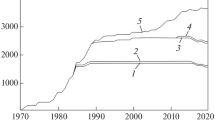Abstract
The recent development of binary geothermal technology is analyzed. General trends in the introduction of low-temperature geothermal sources are summarized. The use of single-phase low-temperature geothermal fluids in binary power plants proves possible and expedient. The benefits of power plants with a binary cycle in comparison with traditional systems are shown. The selection of the working fluid is considered, and the influence of the fluid’s physicochemical properties on the design of the binary power plant is discussed. The design of binary power plants is based on the chemical composition and energy potential of the geothermal fluids and on the landscape and climatic conditions at the intended location. Experience in developing a prototype 2.5 MW Russian binary power unit at Pauzhetka geothermal power plant (Kamchatka) is outlined. Most binary systems are designed individually for a specific location. Means of improving the technology and equipment at binary geothermal power plants are identified. One option is the development of modular systems based on several binary systems that employ the heat from the working fluid at different temperatures.
Similar content being viewed by others
References
G. V. Tomarov, A. I. Nikol’skii, V. N. Semenov, A. A. Shipkov, and V. E. Parshin, “Trends and prospects of development of geothermal power engineering,” Therm. Eng. 59, 831–840 (2012).
L. Y. Bronicki, “Organic Rankine ñycle in geothermal power plants:25years of ORMAT experience,” Geotherm. Res. Coun. Trans. 31, 499–502 (2007).
R. Bertani, “Geothermal power generation in the world 2010–2014 update report,” Proc. World Geothermal Congress, Melbourne, Australia, 2015.
A. Franco, “Power production from a moderate temperature geothermal resource with regenerative organic Rankine cycle,” Energy for Sustainable Development 15, 411–419 (2011).
A. Franco and M. Villani, “Optimal design of binary cycle power plants for water-dominated, medium-temperature geothermal fields,” Geothermics 38, 379–391 (2009).
N. Cirincione, “Design, construction and commissioning of an organic Rankine cycle waste heat recovery system with a Tesla-hybrid turbine expander,” Master’s thesis of the Colorado State University (2011).
G. Angelino, M. Gaia, and E. Macchi, “A review of italian activity in the field of organic Rankine cycles,” Proc. Int. VDI-Seminar, Zurich, Germany, 1984 pp. 465–482.
S. Quolin, A. Declaye, A. Legros, et al., “Working fluid selection and operating maps for organic Rankine cycle expansion machines,” in Proc. Int. Compressor Engineering Conf., Purdue, Liege, Belgium, 2012.
S. Quoilin and V. Lemort, “Technological and economical survey of organic Rankine cycle systems,” in Proc. 5th Eur. Conf. on Economics and Management of Energy in Industry, Vilamoura, 2009.
G. V. Tomarov, A. I. Nikol’skii, V. N. Semenov, and A. A. Shipkov, “Construction of Russia’s pilot binary power unit at the Pauzhet geothermal power station,” Therm. Eng. 57, 925–930 (2010).
A. F. M. Parada, “Geothermal binary cycle power plants principles, operation and maintenance,” in Proc. World Geothermal Congress, Melbourne, Australia, 2015.
G. V. Tomarov, A. I. Nikol’skii, V. N. Semenov, and A. A. Shipkov, “Equipment of the binary-cycle geothermal power unit at the Pauzhet geothermal power station,” Therm. Eng. 61, 406–410 (2014). doi: 10.1134/S0040363614060101
O. V. Britvin, O. A. Povarov, E. F. Klochkov, V. E. Luzin, N. L. Koshkin, and G. V. Tomarov, “The Mutnovsk geothermal power complex in Kamchatka,” Therm. Eng. 48, 89–95 (2001).
O. A. Povarov and G. V. Tomarov, “Development of geothermal power engineering in Russia and abroad,” Therm. Eng. 53, 165–174 (2006).
Author information
Authors and Affiliations
Corresponding author
Additional information
Original Russian Text © G.V. Tomarov, A.A. Shipkov, E.V. Sorokina, 2015, published in Teploenergetika.
Rights and permissions
About this article
Cite this article
Tomarov, G.V., Shipkov, A.A. & Sorokina, E.V. Improving geothermal power plants with a binary cycle. Therm. Eng. 62, 878–885 (2015). https://doi.org/10.1134/S0040601515120101
Published:
Issue Date:
DOI: https://doi.org/10.1134/S0040601515120101



